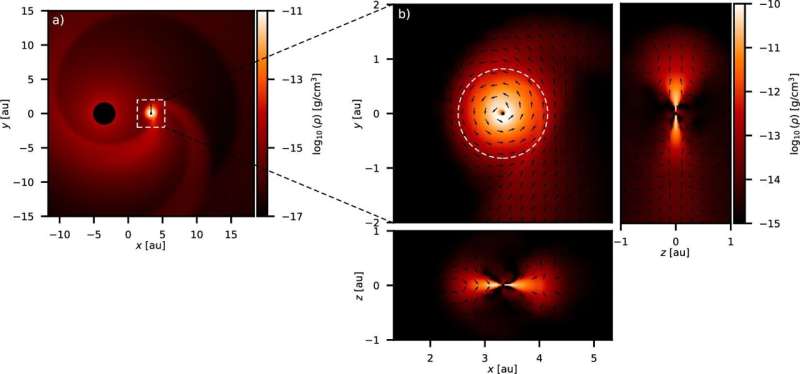Science
ALMA Discovers Companion Orbiting Giant Star π 1 Gruis

An international team of astronomers has successfully identified a companion star orbiting the giant red star known as π 1 Gruis, located approximately 530 light-years from Earth. This discovery, made possible through the advanced capabilities of the Atacama Large Millimeter/submillimeter Array (ALMA) in northern Chile, marks a significant breakthrough in understanding the dynamics of aging stars.
Unraveling the Mysteries of π 1 Gruis
π 1 Gruis, classified as an asymptotic giant branch (AGB) star, has intrigued scientists for years. Once similar to our sun, this massive star has expanded to over 400 times its original size and now shines thousands of times brighter than the sun. AGB stars are known for their ability to create new elements, experience pulsations over varying timescales, and lose substantial amounts of mass over their lifetimes. They ultimately evolve into planetary nebulae, emitting ionized gas as they reach the end of their life cycles.
Detecting companions around such luminous stars has proven challenging due to their overwhelming brightness and fluctuating light levels. The recent study, published in Nature Astronomy, has provided direct observational evidence of a companion star orbiting π 1 Gruis, offering new insights into stellar evolution.
Groundbreaking Observations and Implications
The research team, led by Mats Esseldeurs from KU Leuven, utilized ALMA’s high-resolution capabilities to resolve the orbit of this companion. One of the key contributors, Yoshiya Mori, a Ph.D. candidate in Astrophysics at Monash University, emphasized the importance of accurately determining the mass of π 1 Gruis. “A key part of understanding the orbit of the companion is knowing the mass of the AGB star. Our team helped better constrain this mass by using its observed luminosity and pulsation characteristics to find the best suited stellar model,” Mori noted.
The findings challenge previous models that predicted an elliptical orbit for the companion. Instead, researchers observed an almost perfectly circular orbit, suggesting that the orbital evolution may occur more rapidly than earlier estimates indicated. This revelation may necessitate revisions to existing models concerning the final stages of giant stars with companions.
Esseldeurs highlighted the broader implications of the study, stating, “Understanding how close companions behave under these conditions helps us better predict what will happen to the planets around the sun, and how the companion influences the evolution of the giant star itself.” The analysis also suggests that previously predicted circularization rates may have been underestimated.
The research opens new paths for understanding the physics of tidal interactions and the evolution of binary star systems. As astronomers continue to explore the complexities of AGB stars, discoveries like that of π 1 Gruis enhance our understanding of stellar life cycles and the intricate relationships between stars and their companions.
The full findings are detailed in the paper, “Evidence for the Keplerian orbit of a close companion around a giant star,” published in Nature Astronomy on November 14, 2025. This work represents a significant step in unraveling the mysteries of the cosmos and the life stages of stars.
-

 Science3 weeks ago
Science3 weeks agoOhio State Study Uncovers Brain Connectivity and Function Links
-

 Politics3 weeks ago
Politics3 weeks agoHamas Chief Stresses Disarmament Tied to Occupation’s End
-

 Entertainment3 weeks ago
Entertainment3 weeks agoMegan Thee Stallion Exposes Alleged Online Attack by Bots
-

 Science4 weeks ago
Science4 weeks agoResearchers Challenge 200-Year-Old Physics Principle with Atomic Engines
-

 Entertainment3 weeks ago
Entertainment3 weeks agoPaloma Elsesser Shines at LA Event with Iconic Slicked-Back Bun
-

 World2 weeks ago
World2 weeks agoFDA Unveils Plan to Cut Drug Prices and Boost Biosimilars
-

 Top Stories3 weeks ago
Top Stories3 weeks agoFederal Agents Detain Driver in Addison; Protests Erupt Immediately
-

 Business2 weeks ago
Business2 weeks agoMotley Fool Wealth Management Reduces Medtronic Holdings by 14.7%
-

 Entertainment2 weeks ago
Entertainment2 weeks agoBeloved Artist and Community Leader Gloria Rosencrants Passes Away
-

 Business3 weeks ago
Business3 weeks agoHome Depot Slashes Prices on Halloween Favorites Up to 75%
-

 Top Stories3 weeks ago
Top Stories3 weeks agoOrioles Hire Craig Albernaz as New Manager Amid Rebuild
-

 Business2 weeks ago
Business2 weeks agoShutdown Impacts Millions as Deadline Approaches, Pressures Congress









